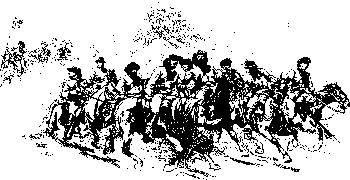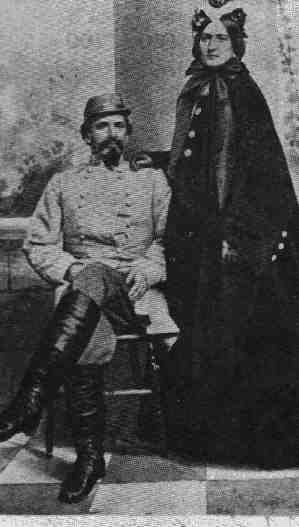Brig. Gen. John Hunt Morgan
Confederate Military History, Volume 9
BY COL. J. STODDARD
JOHNSTON.

Brigadier-General
John Hunt Morgan made one of the most unique records of the war between
the North and South. He was born in Huntsville, Ala., June 1, 1826. When
but four years of age, he was carried by his father to the vicinity of  Lexington,
Ky., where he was brought up on a farm and received a common school education.
He was the oldest of six brothers, all of whom, except one, who was too
young to bear arms, did military service for the Confederate States. It
is said he was a lineal descendant of the celebrated Daniel Morgan of revolutionary
fame. In the war with Mexico, young Morgan raised a company of which he
was made captain. But peace was made before he had entered upon active service*(see
note below). It is stated that upon the disbanding of this company,
Morgan indemnified out of his own means every man for the time that he
had lost. Soon after the Mexican war he engaged in the manufacture of bagging
and jeans for the Southern market. At the commencement of the war he was
detained at home by the illness and death of his wife.
Lexington,
Ky., where he was brought up on a farm and received a common school education.
He was the oldest of six brothers, all of whom, except one, who was too
young to bear arms, did military service for the Confederate States. It
is said he was a lineal descendant of the celebrated Daniel Morgan of revolutionary
fame. In the war with Mexico, young Morgan raised a company of which he
was made captain. But peace was made before he had entered upon active service*(see
note below). It is stated that upon the disbanding of this company,
Morgan indemnified out of his own means every man for the time that he
had lost. Soon after the Mexican war he engaged in the manufacture of bagging
and jeans for the Southern market. At the commencement of the war he was
detained at home by the illness and death of his wife.
 As
soon as he could do so, he secretly collected a band of twenty-five men,
and leaving his home made his way to Green river and reported to the Confederate
officer in command there as ready for duty. He was soon commissioned as
captain of Kentucky volunteers and placed under the command of Gen. Simon
B. Buckner. He was stationed with some other cavalry upon duty on Green
river. He immediately began his wonderful career, keeping the enemy between
Green river and Bacon creek in a constant state of alarm. After the fall
of Fort Donelson he was attached to Hardee's command and told to watch
the movements of the enemy. This he did, and in a series of daring adventures
alarmed the enemy even in the vicinity of Nashville. On the earnest recommendation
of General Beauregard, Morgan was appointed colonel of the Second Kentucky
cavalry April 4, 1862. A short time before Bragg's Kentucky campaign Morgan,
leaving Tennessee with less than 1,000 men, penetrated a country in the
hands of the Federals, captured seventeen towns, destroying all government
supplies and arms in them, dispersed 1,500 horne guards and paroled nearly
1,200 regular troops.
As
soon as he could do so, he secretly collected a band of twenty-five men,
and leaving his home made his way to Green river and reported to the Confederate
officer in command there as ready for duty. He was soon commissioned as
captain of Kentucky volunteers and placed under the command of Gen. Simon
B. Buckner. He was stationed with some other cavalry upon duty on Green
river. He immediately began his wonderful career, keeping the enemy between
Green river and Bacon creek in a constant state of alarm. After the fall
of Fort Donelson he was attached to Hardee's command and told to watch
the movements of the enemy. This he did, and in a series of daring adventures
alarmed the enemy even in the vicinity of Nashville. On the earnest recommendation
of General Beauregard, Morgan was appointed colonel of the Second Kentucky
cavalry April 4, 1862. A short time before Bragg's Kentucky campaign Morgan,
leaving Tennessee with less than 1,000 men, penetrated a country in the
hands of the Federals, captured seventeen towns, destroying all government
supplies and arms in them, dispersed 1,500 horne guards and paroled nearly
1,200 regular troops.
In his official
report of these operations made to Gen. E. Kirby Smith, Morgan says that
he left Knoxville with 900 men and returned with 1,200, having lost of
the number that he carried into Kentucky in killed, wounded and missing
about  90.
During this raid he had destroyed military stores, railroad bridges and
other property to the value of eight or ten million dollars. In this expedition
he had greatly mystified the enemy by an instrument hitherto unused in
offensive warfare. This was a portable electric battery. It was only necessary
to take down the telegraph wire, connect it with his portable battery and
head off and answer all messages passing between Louisville and Nashville.
On his retreat Morgan took possession of the wires on his route and countermanded
all the orders that had been sent to intercept him. In recognition of his
great services he was, on the suggestion of General Bragg, commissioned
brigadier-general December 11, 1862. His exploits made it necessary to
garrison every important town in Kentucky and Southern Ohio and Indiana.
90.
During this raid he had destroyed military stores, railroad bridges and
other property to the value of eight or ten million dollars. In this expedition
he had greatly mystified the enemy by an instrument hitherto unused in
offensive warfare. This was a portable electric battery. It was only necessary
to take down the telegraph wire, connect it with his portable battery and
head off and answer all messages passing between Louisville and Nashville.
On his retreat Morgan took possession of the wires on his route and countermanded
all the orders that had been sent to intercept him. In recognition of his
great services he was, on the suggestion of General Bragg, commissioned
brigadier-general December 11, 1862. His exploits made it necessary to
garrison every important town in Kentucky and Southern Ohio and Indiana.
His
most wonderful exploit was the great raid through those States from the
2d to the 20th of July, 1863. With about 2,000 horsemen and four cannon
he crossed the Cumberland river near Burkesville. Moving rapidly forward
he met and defeated Wolford's Kentucky Union command. At Brandenburg on
the Ohio his bold raiders captured two steamboats. Then, while one half
of the command crossed the Ohio and attacked about 1,000 men on the Indiana
side, Morgan with the other half turned his artillery on two gunboats that
had come down the river to prevent the crossing, and drove them off. Then
crossing the river Morgan dispersed or captured the whole Federal force.
Next he captured Corydon and about 1,200 citizens and soldiers who tried
to defend it. No pillaging was allowed. Only provisions for men and provender
for stock were taken.
At last, after passing
through fifty-two towns, nine in Kentucky, fourteen in Indiana and twenty-nine
in Ohio, and having captured nearly 6,000 prisoners and damaged public
property to the amount of ten million dollars, Morgan and his men were
captured. Some were sent to Camp Morton, Indiana. Morgan and his chief
officers were taken to Columbus, Ohio, where they were treated like common
felons. But Morgan and six of his officers, with no tools but case knives,
cut their way through the solid stone, tunneled underground and made their
escape. In 1864 Morgan was again in the field giving his enemies any amount
of trouble. On the 4th of September, 1864, at Greeneville, Tenn., he was
surrounded by the enemy, and in attempting to escape was shot and instantly
killed. Such was the sad fate of this illustrious cavalry leader.
Hunt-Morgan House
201 N. Mill, Lexington, KY
Home of Gen. Morgan, built by
John Wesley Hunt in 1814. The
Morgan's Men Association help
maintain this historic landmark
as well as a museum on
the second floor.
Note:
According
to author, James A. Ramage, in his book, "Rebel Raider: The Life of General
John Hunt Morgan", John enlisted in Co K, 1st Regiment of Kentucky
Mounted Volunteers on June 9, 1846. Also enlisting was his brother Calvin
and uncle, Alexander Morgan. All three were merely privates in the ranks
eventhough his uncle was offered a commission, he preferred to stay beside
his nephews. On Feb 22, 1847 they arrived at Buena Vista, Mexico
and joined Gen. Zachary Taylor's forces. Here they were outnumbered by
the Mexican Army by over three to one. They fought dismounted and were
reported to have acted with "promptness and bravery" operating with "coolness
and skill". On Feb 23, 1847, the U.S. forces faced a massive attack by
Santa Anna. Under "hot and incessant" enemy fire they "stood as firm as
the rocks of the mountain". After the Indiana and Illinois infantry retreated,
the Kentucky and Arkansas troopers had to fall back to prevent being surrounded.
It was at this moment that Uncle Alexander Morgan and five others of Company
K died. Alexander was reported to have fought the Mexican lancers "until
litterly cut to pieces". After returning back to Kentucky, June 19,
1847, Morgan raised a company of cavalry in hope of returning to the army.
By the time he reached Mexico for this second tour of duty, hostilities
had ended. Back to footnote.
The "Gen. Morgan's Grand March" (by C.
L. Peticolas, 1864 Richmond, Virginia, dedicated to the officers and privates
of Gen. Morgan's Command) midi file from "The Borderland Collection", Copyrighted
1998;
Scott K.Williams,All Rights
Reserved.


 Lexington,
Ky., where he was brought up on a farm and received a common school education.
He was the oldest of six brothers, all of whom, except one, who was too
young to bear arms, did military service for the Confederate States. It
is said he was a lineal descendant of the celebrated Daniel Morgan of revolutionary
fame. In the war with Mexico, young Morgan raised a company of which he
was made captain. But peace was made before he had entered upon active service*(see
note below). It is stated that upon the disbanding of this company,
Morgan indemnified out of his own means every man for the time that he
had lost. Soon after the Mexican war he engaged in the manufacture of bagging
and jeans for the Southern market. At the commencement of the war he was
detained at home by the illness and death of his wife.
Lexington,
Ky., where he was brought up on a farm and received a common school education.
He was the oldest of six brothers, all of whom, except one, who was too
young to bear arms, did military service for the Confederate States. It
is said he was a lineal descendant of the celebrated Daniel Morgan of revolutionary
fame. In the war with Mexico, young Morgan raised a company of which he
was made captain. But peace was made before he had entered upon active service*(see
note below). It is stated that upon the disbanding of this company,
Morgan indemnified out of his own means every man for the time that he
had lost. Soon after the Mexican war he engaged in the manufacture of bagging
and jeans for the Southern market. At the commencement of the war he was
detained at home by the illness and death of his wife.